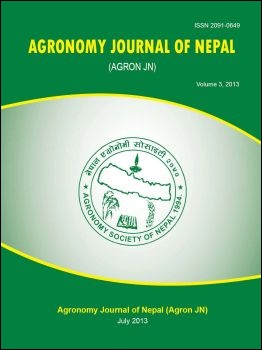Effect of different mulching materials on weed dynamics and yield of direct seeded rice in Chitwan, Nepal
DOI:
https://doi.org/10.3126/ajn.v3i0.9008Keywords:
brown manuring, direct seeded rice, live mulch, weed dynamicsAbstract
An experiment was carried out at farmers' field to compare the effects of live mulches and herbicide on weed growth and dynamics, yield, and economic performance of direct seeded rice under humid sub-tropical condition at Phulbari, Chitwan in 2009. The experiment was conducted in Randomized Complete Block Design with eight treatments and three replications. The treatments consisted of i) control, ii) three hand weeding, iii) herbicide application (bispyribac sodium @ 80 ml/ha) + one hand weeding, iv) wheat straw mulch @ 5t/ha + one hand weeding, v) Eupatorium mulch @ 5t/ha + one hand weeding, vi) brown manuring with Sesbania aculeata @ 30 kg/ha, vii) brown manuring with Sesamum indicum @ 2kg/ha, and viii) brown manuring with Crotolaria juncea @ 30 kg/ha. Weed dry matter accumulation was significantly lower with herbicide application (1.15 g/m2) than wheat straw mulch (6.75 g/m2). The treatments with brown manuring and Eupatorium mulch were found to be equally effective in suppressing the weed growth by reducing both dry matter content and weed density. Application of Eupatorium mulch one day after sowing produced significantly higher grain yield (3.5 t/ha) than control (1.77 t/ha), Sesamum brown manuring (2.97 t/ha) and wheat straw mulch (2.83 t/ha). Yield attributes like effective tillers/m2, panicle length and panicle weight were positively correlated with grain yield (r = 0.540, 0.705, 0.531 and 0.613 respectively). The net profit (Rs. 63.17 x 1000/ha) obtained from the treatment with Eupatorium mulch was higher than other tested treatments. Eupatorium mulch and herbicide application recorded equal benefit cost ratio of 2.4. Cultivation of direct seeded rice with the application of Eupatorium mulch or brown manuring (BM) of Sesamum was found effective for increasing yield and net returns in humid subtropical condition of Chitwan. Live mulching could be an eco-friendly weed control options in DSR. The BM option also provides crop residue for the addition of organic matter. This result suggests that BM is a potential alternative of herbicide application. Either mulching with Eupatorium and wheat straw or growing of Sesbania and Crotolaria as BM with rice up to 30 DAS are advisable to increase productivity with reduced cost of production at Chitwan and similar condition.
Agronomy Journal of Nepal (Agron JN) Vol. 3. 2013, Page 73-81
Downloads
Downloads
Published
How to Cite
Issue
Section
License
ASON permits for free use, distribution and reproduction in any medium if the original work is properly cited and not used for commercial purposes.




